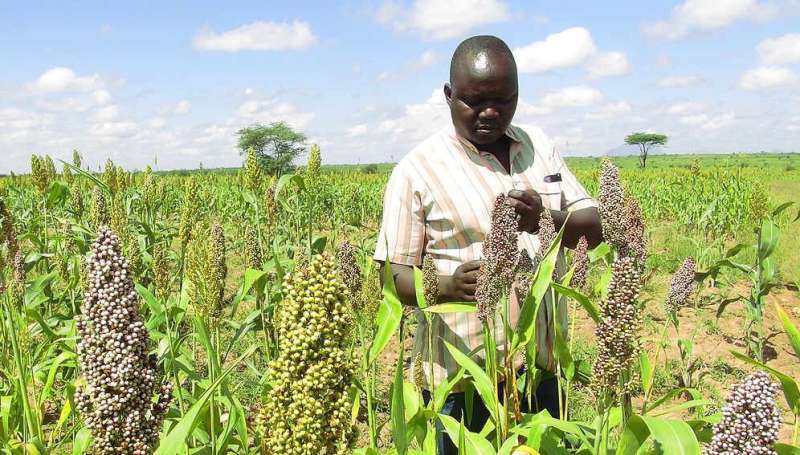Organizations seek to develop drought-resistant crops to tackle food crisis

Agricultural organizations are joining forces to develop drought-resistant crops for farmers in the global South, amid warnings of a global food crisis that threatens the world's poorest.
G7 ministers meeting this week said the world was facing a worsening state of food insecurity and malnutrition as a result of the war in Ukraine, which has driven up food, energy and fertilizer prices with "devastating consequences for some of the most vulnerable people".
The number of people facing food insecurity at "crisis levels or worse" almost doubled from 108 million in 2016 to 193 million in 2021, according to the Global Report on Food Crises 2022, released earlier this month.
Conflict, economic shocks and climate change were cited as leading contributors to acute hunger—a plight facing more than 320 million people this year unless urgent action is taken, the World Food Programme (WFP) has warned.
In response to the report, the International Center for Agricultural Research in the Dry Areas (ICARDA) is launching a new initiative with partners including the Food and Agriculture Organization (FAO) to improve livestock and plant production, says Aladdin Hamwieh, breeder, biotechnologist and Egypt country manager for ICARDA. The strategy also aims to combat soil degradation, preserve fisheries, and strengthen agricultural guidance systems, he says.
"The initiative is based on developing plants that tolerate drought and salinity, such as wheat, barley and chickpeas, through cross-breeding and transfer of genetic traits between different plants to benefit from them," explains Hamwieh.
The center is also working on modern methods of plant breeding, such as speed breeding, to provide small-scale farmers with new varieties that can be cultivated in a short period, he adds.
The FAO has developed a Rapid Response Plan to support the most vulnerable smallholder and medium-sized farming households this year, according to Irina Utkina, a spokesperson for the organization.
But Utkina says a significant increase in funding was needed to provide the emergency and resilience interventions. "Through the 2022 appeal, FAO requires $1.5 billion to assist 50 million people," she tells SciDev.Net.
Improving smallholders' climate resilience is essential, Rob Vos, director of markets, trade and institutions at the International Food Policy Research Institute (IFPRI) tells SciDev.Net.
Immediate relief through humanitarian assistance and fiscal resources are needed to expand social protection programs and support domestic food production, according to Vos. He says preventing further deterioration will require long-term solutions with investment in climate-resilient agriculture and rural livelihoods aligned with peacebuilding.
Ukraine
The number of people facing hunger is expected to increase this year as a result of several drivers, including the Russia-Ukraine war, according to the food crisis report released by the Food Security Information Network and the Global Network Against Food Crises.
The conflict in Ukraine is disrupting the global trade of food, fertilizers and petroleum products, driving up food and fuel prices around the world.
"Food prices have increased by 30 to 50 percent in many markets and doubled in some markets, and the cost of bread has increased by 20 percent in some countries," says Sally Farid, assistant professor of economics at the Faculty of African Graduate Studies at Cairo University in Egypt.
James Belgrave, a WFP spokesperson, tells SciDev.Net: "Conflict, climate extremes and the coronavirus pandemic were already conspiring to create an unprecedented hunger crisis in 2021. Now we have record-high food and fuel prices—driven even higher by the crisis in Ukraine—adding to the crisis."
Belgrave says that in 81 countries where the WFP operates, acute hunger is expected to rise by 47 million people if the conflict in Ukraine continues unabated, with the steepest rises in Sub-Saharan Africa. "This on top of the 276 million who already face acute hunger worldwide, meaning that up to 323 million people could face acute hunger in 2022," he says.
Vos adds: "Not all major food crises countries are affected by the Ukrainian crisis in the same way. Countries like Yemen and Sudan are particularly affected as both are highly dependent on wheat imports for domestic food consumption."
More than half a million people in Ethiopia, southern Madagascar, South Sudan and Yemen were classified in the report as being in a "catastrophic" phase of acute food insecurity, requiring urgent action to save lives.
Almost 70 percent of the total number of people facing acute hunger were in ten countries: the Democratic Republic of Congo, Afghanistan, Ethiopia, Yemen, Nigeria, Syria, Sudan, South Sudan, Pakistan, and Haiti.
Provided by SciDev.Net





















